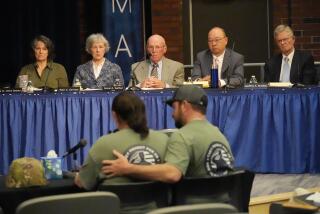Panel Finishes Study of Serb Atrocities
- Share via
WASHINGTON — A U.N. commission has sent the United Nations sheaves of documentation to buttress its charge that the Serbian government and military coordinated or acquiesced in war atrocities inflicted by Bosnian Serbs on the Muslim population of Bosnia-Herzegovina.
The documentation is part of 3,000 pages of annexes to the Commission of Experts’ final report on war crimes in the Balkans. These annexes, according to commission Chairman Cherif Bassiouni, “make up the most complete and comprehensive study of the conflict both in terms of the military operations and of the violations of humanitarian law that have occurred.”
The final report, without the annexes, was issued in May, 1994, when the commission ended its work. The annexes are to be published in April. The commission provided copies to The Times.
In an interview, Bassiouni, a professor of law at DePaul University in Chicago, deplored the U.N. decision to let the commission die last year when the Security Council appointed Robert Goldstone as the prosecutor for the new War Crimes Tribunal in The Hague. Although the commission turned over 65,000 pages of documentation to Goldstone, Bassiouni said that the job of collecting this kind of evidence needs to go on.
“My concern is that there is nobody now to take over amassing details about all of these violations,” he said. “The prosecutor has his hands full in gathering evidence to prosecute individual cases. He does not have the personnel or the resources or, for that matter, the mandate to look at the overall picture. The overall picture will be lost.”
That picture, as laid out in the annexes, is a grim one. Although the commission finds evidence of war crimes on all sides, it contends that the main perpetrators are Serbs and the main victims Bosnian Muslims.
According to the commission, the practice of “ethnic cleansing”--the removal or extermination of Muslims and Croats from areas that the Serbs want for themselves--followed a discernible pattern.
“First, Bosnian Serb paramilitary forces, often with the assistance of the JNA (the Yugoslav National Army), seize control of the area,” the commission said. “The homes of non-Serb residents are targeted for destruction, and cultural and religious monuments, especially churches and mosques, are destroyed. Second, the area falls under the control of paramilitary forces (that) terrorize the non-Serb residents with random killings, rapes and looting.”
Later, the annexes report, “non-Serb residents are detained, beaten and sometimes transferred to prison camps where further abuse, including mass killings, have occurred.”
*
If the Bosnian Serb army had been powerful enough, the commission goes on, it could have transported the non-Serbs elsewhere. Instead, according to the annexes, “Serb officials relied on the use of terror, entailing mass killings, torture, rapes and prison camps to eradicate the non-Serb population.”
The commission said it had identified 83 paramilitary groups operating in the territories of the former Yugoslav federation, 56 of them working in support of either Serbia, the Croatian Serbs or the Bosnian Serbs. Most of these units, the annexes say, support themselves through looting, theft, ransom and contraband. “There is substantial evidence,” the commission said, “that Serbian government or military officials have coordinated, or at least have been aware of, the activities of the Serbian paramilitary or special forces.”
The commission cited reports that many paramilitary soldiers wear uniforms of the Yugoslav army and that outside coordination is evident as some of the units conduct joint operations or move swiftly from one area to another.
More to Read
Sign up for Essential California
The most important California stories and recommendations in your inbox every morning.
You may occasionally receive promotional content from the Los Angeles Times.










